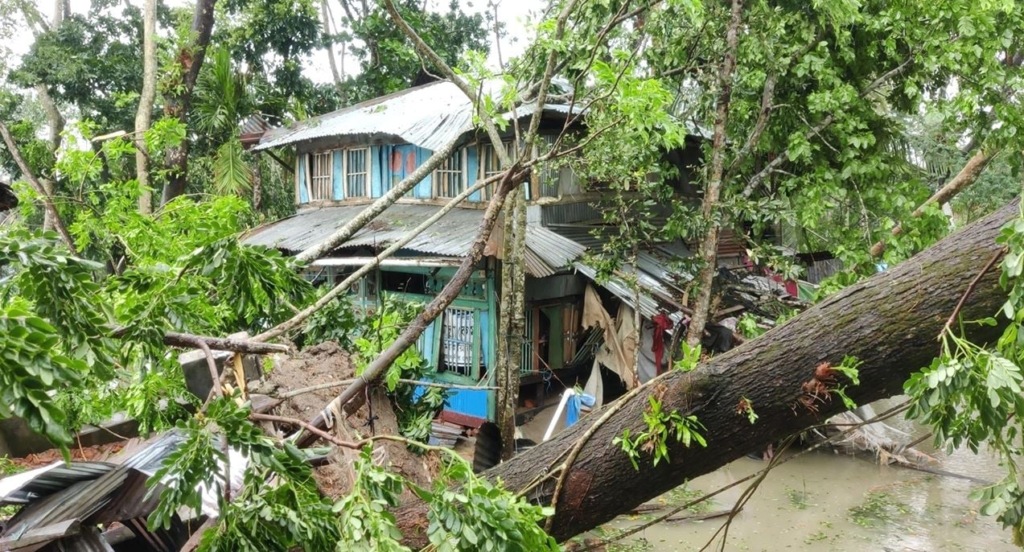Six persons — one in Kolkata, two women in South 24 Parganas district, one in Panihati in North 24 Parganas and a father-son duo in Purba Medinipur killed to the cyclone.

BSS
AMN / WEB DESK
At least 10 persons were killed and millions were left without power as severe cyclone Remal lashed the coasts of Bangladesh with devastating winds of up to 120 kph and storm surges, inundating hundreds of villages.
Remal weakened into a cyclonic storm on Monday morning, sustaining wind speeds of 80-90 kph, following landfall around midnight of Sunday, the Met department said.
Bangladesh minister for disaster management and relief Mohibbur Rahman said 10 people were killed in the official count so far while the storm entirely damaged over 35 households and affected over 3.75 million people.
Officials in coastal areas said, of the dead some drowned and others were crushed when their houses collapsed.
The cyclone brought with it strong gales and heavy downpours alongside high tides cutting power and road communication lines while officials said many lives were saved as some 800,000 people were moved to cyclone shelters further inside the mainland.
Weather officials said the expansive Sundarbans forest, the world’s largest mangrove vegetation where the three major rivers of the Ganges, Brahmaputra and Meghna meet the sea helped dissipate the worst of the storm.
According to the met office, southwestern Patuakhali was the worst victim of the severe storm where the wind speed rose up to 111 kilometers per hour with tidal surges accompanying the storm flooded and ravaged huge infrastructure including thatched houses.
“The crashing waves virtually washed away everything as it proceeded through the area, particularly Khepupara . . . it became extremely fierce for over half an hour from 1.30 am after the midnight,” a cyclone control room official in Patuakhali said by phone.
The cyclone-driven surges breached a major town protection embankment on the country’s Manpura Island inundating the most parts of the island.
Power ministry officials said they shut down electricity supply to some areas in advance to avoid accidents, while in several coastal areas fallen trees and snapped electricity lines further disrupted supply.
They said nearly three million people in Bangladesh were without electricity while power supply disruptions affected the capital Dhaka as well while residents said their cell phone services too were inoperative as the devices could not be recharged. With the improvement of the situation, the authorities have started restoring the power transmission and distribution system gradually after necessary checking, said Bangladesh Rural Electrification Board (BREB).
According to the Ministry of Disaster Management and Relief, over 3,758,096 people were affected and 35,483 houses were destroyed in 19 districts-Khulna, Satkhira, Bagherhat, Jhalokathi, Barishal, Patuakhali, Pirojpur, Barguna, Bhola, Feni, Cox’s Bazar, Chattogram, Noakhali, Lakhipur, Chandpur, Narail, Gopalganj, Shariatpur and Jashore.
Meanwhile, nearly 29,500 houses in 24 blocks and 79 municipal wards, mostly in the south coastal areas of West Bengal, were partially or entirely damaged by the cyclone, a state government official said on Monday.
Six persons — one in Kolkata, two women in South 24 Parganas district, one in Panihati in North 24 Parganas district and a father-son duo in Memari in Purba Medinipur — lost their lives due to the cyclone.
Over 2,140 trees were uprooted, and about 1,700 electric poles fell in various parts of the state, he added.
Initial assessments indicate that out of the damaged houses, 27,000 suffered partial damage, while 2,500 were completely destroyed. The official cautioned that these figures might change as evaluations are ongoing, with data collection and damage estimation still in progress.
The administration had shifted 2,07,060 people to 1,438 safe shelters, he said, adding currently there are 77,288 people.
“In all, 341 gruel kitchens being operated at the moment. We have distributed 17,738 tarpaulins to the affected people in the coastal and low-lying areas,” he added.
